Publications
Filter by type:
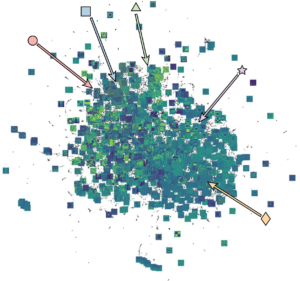
Symmetry-aware recursive image similarity exploration for materials microscopy
In pursuit of scientific discovery, vast collections of unstructured structural and functional images are acquired; however, only an infinitesimally small fraction of this data is rigorously analyzed, with an even smaller fraction ever being published. One method to accelerate scientific discovery is to extract more insight from costly scientific experiments already conducted. Unfortunately, data from scientific experiments tend only to be accessible by the originator who knows the experiments and directives. Moreover, there are no robust methods to search unstructured databases of images to deduce correlations and insight. Here, we develop a machine learning approach to create image similarity projections to search unstructured image databases. To improve these projections, we develop and train a model to include symmetry-aware features. As an exemplar, we use a set of 25,133 piezoresponse force microscopy images collected on diverse materials systems over five years. We demonstrate how this tool can be used for interactive recursive image searching and exploration, highlighting structural similarities at various length scales. This tool justifies continued investment in federated scientific databases with standardized metadata schemas where the combination of filtering and recursive interactive searching can uncover synthesis-structure-property relations. We provide a customizable open-source package (https://github.com/m3-learning/Recursive_Symmetry_Aware_Materials_Microstructure_Explorer) of this interactive tool for researchers to use with their data.
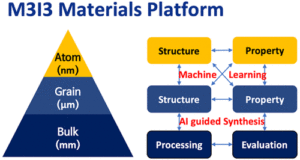
Reducing Time to Discovery: Materials and Molecular Modeling, Imaging, Informatics, and Integration
Multiscale and multimodal imaging of material structures and properties provides solid ground on which materials theory and design can flourish. Recently, KAIST announced 10 flagship research fields, which include KAIST Materials Revolution: Materials and Molecular Modeling, Imaging, Informatics and Integration (M3I3). The M3I3 initiative aims to reduce the time for the discovery, design and development of materials based on elucidating multiscale processing–structure–property relationship and materials hierarchy, which are to be quantified and understood through a combination of machine learning and scientific insights. In this review, we begin by introducing recent progress on related initiatives around the globe, such as the Materials Genome Initiative (U.S.), Materials Informatics (U.S.), the Materials Project (U.S.), the Open Quantum Materials Database (U.S.), Materials Research by Information Integration Initiative (Japan), Novel Materials Discovery (E.U.), the NOMAD repository (E.U.), Materials Scientific Data Sharing Network (China), Vom Materials Zur Innovation (Germany), and Creative Materials Discovery (Korea), and discuss the role of multiscale materials and molecular imaging combined with machine learning in realizing the vision of M3I3. Specifically, microscopies using photons, electrons, and physical probes will be revisited with a focus on the multiscale structural hierarchy, as well as structure–property relationships. Additionally, data mining from the literature combined with machine learning will be shown to be more efficient in finding the future direction of materials structures with improved properties than the classical approach. Examples of materials for applications in energy and information will be reviewed and discussed. A case study on the development of a Ni–Co–Mn cathode materials illustrates M3I3’s approach to creating libraries of multiscale structure–property–processing relationships. We end with a future outlook toward recent developments in the field of M3I3
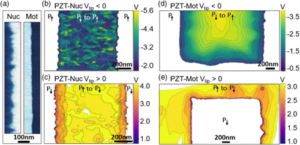
Local Probe Comparison of Ferroelectric Switching Event Statistics in the Creep and Depinning Regimes in Pb(Zr0.2Ti0.8)O3 Thin Films
Ferroelectric materials provide a useful model system to explore the jerky, highly nonlinear dynamics of elastic interfaces in disordered media. The distribution of nanoscale switching event sizes is studied in two Pb(Zr<sub>0.2</sub>Ti<sub>0.8</sub>)O<sub>3</sub> thin films with different disorder landscapes using piezoresponse force microscopy. While the switching event statistics show the expected power-law scaling, significant variations in the value of the scaling exponent τ are seen, possibly as a consequence of the different intrinsic disorder landscapes in the samples and of further alterations under high tip bias applied during domain writing. Importantly, higher exponent values (1.98–2.87) are observed when crackling statistics are acquired only for events occurring in the creep regime. The exponents are systematically lowered when all events across both creep and depinning regimes are considered—the first time such a distinction is made in studies of ferroelectric materials. These results show that distinguishing the two regimes is of crucial importance, significantly affecting the exponent value and potentially leading to incorrect assignment of universality class.
Machine learning (ML) is making a huge impact on our society and daily lives through advancements in computer vision, natural language processing, and autonomous vehicles, among others. ML is also powering scientific advances which can lead to future paradigm shifts in a broad range of domains, including particle physics, plasma physics, astronomy, neuroscience, chemistry, material science, and biomedical engineering. Scientific discoveries come from groundbreaking ideas and the capability to validate those ideas by testing nature at new scales—finer and more precise temporal and spatial resolution. This is leading to an explosion of data that must be interpreted, and ML is proving a powerful approach. The more efficiently we can test our hypotheses, the faster we can achieve discovery. To fully unleash the power of ML and accelerate discoveries, it is necessary to embed it into our scientific process, into our instruments and detectors. It is in this spirit that the Fast Machine Learning for Science community1 has been built. Two workshops have also been organized through this growing community and are the source for this report. The community brings together an extremely wide-ranging group of domain experts who would rarely interact as a whole. One of the underlying benefits of ML is the portability and general applicability of the techniques that can enable experts from seemingly unrelated domains to find a common language. Scientists and engineers from particle physicists to networking experts and biomedical engineers are represented and can interact with experts in fundamental ML techniques and compute systems architects. This report aims to summarize the progress in the community to understand how our scientific challenges overlap and where there are potential commonalities in data representations, ML approaches, and technology, including hardware and software platforms. Therefore, the content of the report includes the following: descriptions of a number of different scientific domains including existing work and applications for embedded ML; potential overlaps across scientific domains in data representation or system constraints; and an overview of state-of-the-art techniques for efficient machine learning and compute platforms, both cutting-edge and speculative technologies. Necessarily, such a broad scope of topics cannot be comprehensive. For the scientific domains, we note that the contributions are examples of how ML methods are currently being or planned to be deployed. We hope that giving a glimpse into specific applications will inspire readers to find more novel use-cases and potential overlaps. The summaries of state-of-the-art techniques we provide relate to rapidly developing fields and, as such, may become out of date relatively quickly. The goal is to give non-experts an overview and taxonomy of the different techniques and a starting point for further investigation. To be succinct, we rely heavily on providing references to studies and other overviews while describing most modern methods. We hope the reader finds this report both instructive and motivational. Feedback and input to this report, and to the larger community, are welcome and appreciated.
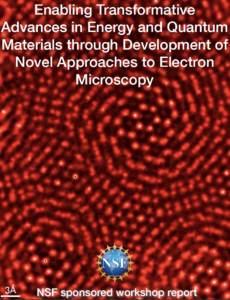
The goal of this workshop is to identify novel scientific infrastructure advances in the field of electron microscopy that will have a transformative impact on areas of energy and quantum science and technology.
This workshop will be immersive and highly interactive. Each session will build on the work of the one before. We expect and anticipate that you will be able to participate in the whole event.
Application of a long short-term memory for deconvoluting conductance contributions at charged ferroelectric domain walls
Ferroelectric domain walls are promising quasi-2D structures that can be leveraged for miniaturization of electronics components and new mechanisms to control electronic signals at the nanoscale. Despite the significant progress in experiment and theory, however, most investigations on ferroelectric domain walls are still on a fundamental level, and reliable characterization of emergent transport phenomena remains a challenging task. Here, we apply a neural-network-based approach to regularize local I(V)-spectroscopy measurements and improve the information extraction, using data recorded at charged domain walls in hexagonal (Er0.99,Zr0.01)MnO3 as an instructive example. Using a sparse long short-term memory autoencoder, we disentangle competing conductivity signals both spatially and as a function of voltage, facilitating a less biased, unconstrained and more accurate analysis compared to a standard evaluation of conductance maps. The neural-network-based analysis allows us to isolate extrinsic signals that relate to the tip-sample contact and separating them from the intrinsic transport behavior associated with the ferroelectric domain walls in (Er0.99,Zr0.01)MnO3. Our work expands machine-learning-assisted scanning probe microscopy studies into the realm of local conductance measurements, improving the extraction of physical conduction mechanisms and separation of interfering current signals.

Revealing ferroelectric switching character using deep recurrent neural networks
The ability to manipulate domains underpins function in applications of ferroelectrics. While there have been demonstrations of controlled nanoscale manipulation of domain structures to drive emergent properties, such approaches lack an internal feedback loop required for automatic manipulation. Here, using a deep sequence-to-sequence autoencoder we automate the extraction of latent features of nanoscale ferroelectric switching from piezoresponse force spectroscopy of tensile-strained PbZr0.2Ti0.8O3 with a hierarchical domain structure. We identify characteristic behavior in the piezoresponse and cantilever resonance hysteresis loops, which allows for the classification and quantification of nanoscale-switching mechanisms. Specifically, we identify elastic hardening events which are associated with the nucleation and growth of charged domain walls. This work demonstrates the efficacy of unsupervised neural networks in learning features of a material’s physical response from nanoscale multichannel hyperspectral imagery and provides new capabilities in leveraging in operando spectroscopies that could enable the automated manipulation of nanoscale structures in materials.
Understanding the Role of Ferroelastic Domains on the Pyroelectric and Electrocaloric Effects in Ferroelectric Thin Films
Temperature‐ and electric‐field‐induced structural transitions in a polydomain ferroelectric can have profound effects on its electrothermal susceptibilities. Here, the role of such ferroelastic domains on the pyroelectric and electrocaloric response is experimentally investigated in thin films of the tetragonal ferroelectric PbZr<sub>0.2</sub>Ti<sub>0.8</sub>O<sub>3</sub>. By utilizing epitaxial strain, a rich set of ferroelastic polydomain states spanning a broad thermodynamic phase space are stabilized. Using temperature‐dependent scanning‐probe microscopy, X‐ray diffraction, and high‐frequency phase‐sensitive pyroelectric measurements, the propensity of domains to reconfigure under a temperature perturbation is quantitatively studied. In turn, the “extrinsic” contributions to pyroelectricity exclusively due to changes between the ferroelastic domain population is elucidated as a function of epitaxial strain. Further, using highly sensitive thin‐film resistive thermometry, direct electrocaloric temperature changes are measured on these polydomain thin films for the first time. The results demonstrate that temperature‐ and electric‐field‐driven domain interconversion under compressive strain diminish both the pyroelectric and the electrocaloric effects, while both these susceptibilities are enhanced due to the exact‐opposite effect from the extrinsic contributions under tensile strain.
Subtractive fabrication of ferroelectric thin films with precisely controlled thickness
The ability to control thin-film growth has led to advances in our understanding of fundamental physics as well as to the emergence of novel technologies. However, common thin-film growth techniques introduce a number of limitations related to the concentration of defects on film interfaces and surfaces that limit the scope of systems that can be produced and studied experimentally. Here, we developed an ion-beam based subtractive fabrication process that enables creation and modification of thin films with pre-defined thicknesses. To accomplish this we transformed a multimodal imaging platform that combines time-of-flight secondary ion mass spectrometry with atomic force microscopy to a unique fabrication tool that allows for precise sputtering of the nanometer-thin layers of material. To demonstrate fabrication of thin-films with in situ feedback and control on film thickness and functionality we systematically studied thickness dependence of ferroelectric switching of lead-zirconate-titanate, within a single epitaxial film. Our results demonstrate that through a subtractive film fabrication process we can control the piezoelectric response as a function of film thickness as well as improve on the overall piezoelectric response versus an untreated film.
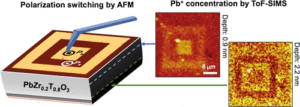
Nanoscale Electrochemical Phenomena of Polarization Switching in Ferroelectrics
Polarization switching is a fundamental feature of ferroelectric materials, enabling a plethora of applications and captivating the attention of the scientific community for over half a century. Many previous studies considered ferroelectric switching as a purely physical process, whereas polarization is fully controlled by the superposition of electric fields. However, screening charge is required for thermodynamic stability of the single domain state that is of interest in many technological applications. The screening process has always been assumed to be fast; thus, the rate-limiting phenomena were believed to be domain nucleation and domain wall dynamics. In this manuscript, we demonstrate that polarization switching under an atomic force microscopy tip leads to reversible ionic motion in the top 3 nm of PbZr0.2Ti0.8O3 surface layer. This evidence points to a strong chemical component to a process believed to be purely physical and has major implications for understanding ferroelectric materials, making ferroelectric devices, and interpreting local ferroelectric switching.
Machine Detection of Enhanced Electromechanical Energy Conversion in PbZr0.2Ti0.8O3 Thin Films
Many energy conversion, sensing, and microelectronic applications based on ferroic materials are determined by the domain structure evolution under applied stimuli. New hyperspectral, multidimensional spectroscopic techniques now probe dynamic responses at relevant length and time scales to provide an understanding of how these nanoscale domain structures impact macroscopic properties. Such approaches, however, remain limited in use because of the difficulties that exist in extracting and visualizing scientific insights from these complex datasets. Using multidimensional band‐excitation scanning probe spectroscopy and adapting tools from both computer vision and machine learning, an automated workflow is developed to featurize, detect, and classify signatures of ferroelectric/ferroelastic switching processes in complex ferroelectric domain structures. This approach enables the identification and nanoscale visualization of varied modes of response and a pathway to statistically meaningful quantification of the differences between those modes. Among other things, the importance of domain geometry is spatially visualized for enhancing nanoscale electromechanical energy conversion.
Local control of defects and switching properties in ferroelectric thin films
Electric-field switching of polarization is the building block of a wide variety of ferroelectric devices. In turn, understanding the factors affecting ferroelectric switching and developing routes to control it are of great technological significance. This work provides systematic experimental evidence of the role of defects in affecting ferroelectric-polarization switching and utilizes the ability to deterministically create and spatially locate point defects in PbZr0.2Ti0.8O3 thin films via focused-helium-ion bombardment and the subsequent defect-polarization coupling as a knob for on-demand control of ferroelectric switching (e.g., coercivity and imprint). At intermediate ion doses (0.22-2.2×1014 ions cm-2), the dominant defects (isolated point defects and small clusters) show a weak interaction with domain walls (pinning potentials from 200-500 K MV cm-1), resulting in small and symmetric changes in the coercive field. At high doses (0.22-1 x 1015 ions cm-2), on the other hand, the dominant defects (larger defect complexes and clusters) strongly pin domain-wall motion (pinning potentials from 500 to 1600 K MV cm-1), resulting in a large increase in the coercivity and imprint, and a reduction in the polarization. This local control of ferroelectric switching provides a route to produce novel functions; namely, tunable multiple polarization states, rewritable pre-determined 180° domain patterns, and multiple zero-field piezoresponse and permittivity states. Such an approach opens up pathways to achieve multilevel data storage and logic, nonvolatile self-sensing shape-memory devices, and nonvolatile ferroelectric field-effect transistors.
Three‐state ferroelastic switching and large electromechanical responses in PbTiO3 thin films
Leveraging competition between energetically degenerate states to achieve large field‐driven responses is a hallmark of functional materials, but routes to such competition are limited. Here, a new route to such effects involving domain‐structure competition is demonstrated, which arises from strain‐induced spontaneous partitioning of PbTiO3 thin films into nearly energetically degenerate, hierarchical domain architectures of coexisting c/a and a1/a2 domain structures. Using band‐excitation piezoresponse force microscopy, this study manipulates and acoustically detects a facile interconversion of different ferroelastic variants via a two‐step, three‐state ferroelastic switching process (out‐of‐plane polarized c+ → in‐plane polarized a → out‐of‐plane polarized c− state), which is concomitant with large nonvolatile electromechanical strains (≈1.25%) and tunability of the local piezoresponse and elastic modulus. It is further demonstrated that deterministic, nonvolatile writing/erasure of large‐area patterns of this electromechanical response is possible, thus showing a new pathway to improved function and properties.
Large polarization gradients and temperature-stable responses in compositionally-graded ferroelectrics
A range of modern applications require large and tunable dielectric, piezoelectric or pyroelectric response of ferroelectrics. Such effects are intimately connected to the nature of polarization and how it responds to externally applied stimuli. Ferroelectric susceptibilities are, in general, strongly temperature dependent, diminishing rapidly as one transitions away from the ferroelectric phase transition (TC). In turn, researchers seek new routes to manipulate polarization to simultaneously enhance susceptibilities and broaden operational temperature ranges. Here, we demonstrate such a capability by creating composition and strain gradients in Ba1−xSrxTiO3 films which result in spatial polarization gradients as large as 35 μC cm−2 across a 150 nm thick film. These polarization gradients allow for large dielectric permittivity with low loss (ɛr≈775, tan δ<0.05), negligible temperature-dependence (13% deviation over 500 °C) and high-dielectric tunability (greater than 70% across a 300 °C range). The role of space charges in stabilizing polarization gradients is also discussed.
Structural phase diagram and pyroelectric properties of free-standing ferroelectric/non-ferroelectric multilayer heterostructures
Ginzburg-Landau-Devonshire models are used to explore ferroelectric phases and pyroelectric coefficients of symmetric free-standing, thin-film trilayer heterostructurescomposed of a ferroelectric and two identical non-ferroelectric layers. Using BaTiO3 as a model ferroelectric, we explore the influence of temperature, in-plane misfit strain, and the non-ferroelectric layer (including effects of elastic compliance and volume fraction) on the phase evolution in the ferroelectric. The resulting phase diagram reveals six stable phases, two of which are not observed for thin films on semi-infinite cubic substrates. From there, we focus on heterostructures with non-ferroelectric layers of commonly available scandate materials which are widely used as substrates for epitaxial growth. Again, six phases with volatile phase boundaries are found in the phase diagram for the NdScO3/BaTiO3/NdScO3trilayerheterostructures. The evolution of polarization and pyroelectric coefficients in the free-standing NdScO3 trilayer heterostructures is discussed with particular attention to the role that heterostructure design plays in influencing the phase evolution and temperature-dependence with a goal of creating enhanced pyroelectric response and advantages over traditional thin-film heterostructures.
Strain-induced growth instability and nanoscale surface patterning in perovskite thin films
Despite extensive studies on the effects of epitaxial strain on the evolution of the lattice and properties of materials, considerably less work has explored the impact of strain on growth dynamics. In this work, we demonstrate a growth-mode transition from 2D-step flow to self-organized, nanoscale 3D-island formation in PbZr0.2Ti0.8O3/SrRuO3/SrTiO3 (001) heterostructures as the kinetics of the growth process respond to the evolution of strain. With increasing heterostructure thickness and misfit dislocation formation at the buried interface, a periodic, modulated strain field is generated that alters the adatom binding energy and, in turn, leads to a kinetic instability that drives a transition from 2D growth to ordered, 3D-island formation. The results suggest that the periodically varying binding energy can lead to inhomogeneous adsorption kinetics causing preferential growth at certain sites. This, in conjunction with the presence of an Ehrlich-Schwoebel barrier, gives rise to long-range, periodically-ordered arrays of so-called “wedding cake” 3D nanostructures which self-assemble along the [100] and [010].
New modalities of strain-control of ferroelectric thin films
Ferroelectrics, with their spontaneous switchable electric polarization and strong coupling between their electrical, mechanical, thermal, and optical responses, provide functionalities crucial for a diverse range of applications. Over the past decade, there has been significant progress in epitaxial strain engineering of oxide ferroelectric thin films to control and enhance the nature of ferroelectric order, alter ferroelectric susceptibilities, and to create new modes of response which can be harnessed for various applications. This review aims to cover some of the most important discoveries in strain engineering over the past decade and highlight some of the new and emerging approaches for strain control of ferroelectrics. We discuss how these new approaches to strain engineering provide promising routes to control and decouple ferroelectric susceptibilities and create new modes of response not possible in the confines of conventional strain engineering. To conclude, we will provide an overview and prospectus of these new and interesting modalities of strain engineering helping to accelerate their widespread development and implementation in future functional devices.
Highly mobile ferroelastic domain walls in compositionally graded ferroelectric thin films
Domains and domain walls are critical in determining the response of ferroelectrics, and the ability to controllably create, annihilate, or move domains is essential to enable a range of next-generation devices. Whereas electric-field control has been demonstrated for ferroelectric 180° domain walls, similar control of ferroelastic domains has not been achieved. Here, using controlled composition and strain gradients, we demonstrate deterministic control of ferroelastic domains that are rendered highly mobile in a controlled and reversible manner. Through a combination of thin-film growth, transmission-electron-microscopy-based nanobeam diffraction and nanoscale band-excitation switching spectroscopy, we show that strain gradients in compositionally graded PbZr1−xTixO3 heterostructures stabilize needle-like ferroelastic domains that terminate inside the film. These needle-like domains are highly labile in the out-of-plane direction under applied electric fields, producing a locally enhanced piezoresponse. This work demonstrates the efficacy of novel modes of epitaxy in providing new modalities of domain engineering and potential for as-yet-unrealized nanoscale functional devices.
Multifunctional, complex oxides capable of exhibiting highly-coupled electrical, mechanical, thermal, and magnetic susceptibilities have been pursued to address a range of salient technological challenges. Today, efforts are focused on addressing the pressing needs of a range of applications and identifying, understanding, and controlling materials with the potential for enhanced or novel responses. In this prospective, we highlight important developments in theoretical and computational techniques, materials synthesis, and characterization techniques. We explore how these new approaches could revolutionize our ability to discover, probe, and engineer these materials and provide a context for new arenas where these materials might make an impact.
Complex Evolution of Built-in Potential in Compositionally-Graded PbZr1–xTixO3 Thin Films
Epitaxial strain has been widely used to tune crystal and domain structures in ferroelectric thin films. New avenues of strain engineering based on varying the composition at the nanometer scale have been shown to generate symmetry breaking and large strain gradients culminating in large built-in potentials. In this work, we develop routes to deterministically control these built-in potentials by exploiting the interplay between strain gradients, strain accommodation, and domain formation in compositionally graded PbZr1–xTixO3 heterostructures. We demonstrate that variations in the nature of the compositional gradient and heterostructure thickness can be used to control both the crystal and domain structures and give rise to nonintuitive evolution of the built-in potential, which does not scale directly with the magnitude of the strain gradient as would be expected. Instead, large built-in potentials are observed in compositionally-graded heterostructures that contain (1) compositional gradients that traverse chemistries associated with structural phase boundaries (such as the morphotropic phase boundary) and (2) ferroelastic domain structures. In turn, the built-in potential is observed to be dependent on a combination of flexoelectric effects (i.e., polarization–strain gradient coupling), chemical-gradient effects (i.e., polarization–chemical potential gradient coupling), and local inhomogeneities (in structure or chemistry) that enhance strain (and/or chemical potential) gradients such as areas with nonlinear lattice parameter variation with chemistry or near ferroelastic domain boundaries. Regardless of origin, large built-in potentials act to suppress the dielectric permittivity, while having minimal impact on the magnitude of the polarization, which is important for the optimization of these materials for a range of nanoapplications from vibrational energy harvesting to thermal energy conversion and beyond.
New modalities of strain-based engineering of ferroelectrics: Domain structure and properties of PbZr1−xTixO3 thin films
Epitaxial strain has been widely used to modify the crystal and domain structure, and ultimately the dielectric, ferroelectric, and pyroelectric responses of ferroelectric thin-films for a wide variety of applications including memories, transducers, energy harvesters, sensors, and many more. Traditionally, the ability to engineer materials using epitaxial strain has been confined to a limited range of materials systems which are closely lattice matched to commercially available substrates. In turn, considering the PbZr1−x TixO3system, a model ferroelectric, study of strain effects has been primarily limited to the Ti-rich variants where a wealth of closely lattice matched substrates (∼±1%) exists, enabling nearly-coherently-strained films to be obtained. While these studies have generated a wealth of knowledge on the basic effects of epitaxial strain and have demonstrated the ability to enhance ferroelectric susceptibilities, these improvements have only been incremental. In the present work, we seek to expand the bounds of epitaxial strain engineering through the use of chemistry, controlled epitaxial strain (and relaxation), and compositional and strain gradients with the directive of generating phase competition and high-energy ferroelastic domain structures to enhance ferroelectric susceptibilities. We, for the first time, grow epitaxial thin films of PbZr1−xTixO 3 across the compositional phase diagram, and show that the rate of strain relaxation is significantly enhanced at the morphotropic phase boundary (PbZr0.52Ti0.48O3), as the result of the high adaptability of the crystal and domain structure. Despite the appearance of nearly “relaxed” crystal structures, PbZr0.52Ti 0.48O3 thin films were shown to exhibit significantly different dielectric responses when grown on various substrates. Highlighting the more nuanced effects of partial strain relaxation in tuning ferroelectric susceptibilities. We then proceed to extend the bounds of epitaxial strain by growing compositionally-graded heterostructures which facilitates the retention of strains in excess of 3.5%, large strain gradients (∼4.35×10−5 m −1), and has the ability to stabilize the tetragonal crystal and domain structure, in PbZr1−xTixO3 solid solutions that are rhombohedral in the bulk. Furthermore, we show that by varying the compositional-gradient form (in terms of the nature of the compositional gradient and heterostructure thickness) that it is possible to generate large built-in potentials, which significantly suppresses the dielectric response, but has minimal detrimental impact on the ferroelectric and pyroelectric susceptibilities, giving rise to dramatically enhanced pyroelectric figures of merit. Additionally, we show that the magnitude of the built-in potential does not follow predictions based on the magnitude of the strain gradient alone, and instead, is enhanced by local strain gradients which occur when traversing chemistries associated with structural phase boundaries (where there are abrupt changes in the lattice parameter) and at/near ferroelastic domain boundaries. Finally, we explore the nanoscale response of these ferroelastic domains in compositionally-graded heterostructures using a combination of transmission electron microscopy-based nanobeam diffraction strain mapping and multi-dimensional band-excitation switching spectroscopy. We observe that the presence of compositional and strain gradients can preferentially stabilize highly-energetic, needle-like domains, which under electrical excitation are highly labile in the out-of-plane direction (while remaining spatially fixed in the plane). These labile domain walls act like domain wall springs (enhancing the magnitude of the built-in potential), transferring elastic energy between the a and c domains (depending on the direction of the applied bias), and giving rise to locally enhanced piezoresponse at the a domains, as the result of a switching mechanism where the a domains expand towards the free surface or are nearly excluded from the film (once again, depending on the direction of applied bias). These studies demonstrate the efficacy of compositional and strain gradients as a new modality of strain engineering capable of significantly altering the crystal and domain structure, and ferroelectric susceptibilities of ferroelectric thin films inconceivable in the absence of compositional/strain gradients.
Tuning Susceptibility via Misfit Strain in Relaxed Morphotropic Phase Boundary PbZr1‐xTixO3 Epitaxial Thin Films
Epitaxial strain is a powerful tool to manipulate the properties of ferroelectric materials. But despite extensive work in this regard, few studies have explored the effect of epitaxial strain on PbZr0.52Ti0.48O3. Here we explore how epitaxial strain impacts the structure and properties of 75 nm thick films of the morphotropic phase boundary composition. Single‐phase, fully epitaxial films are found to possess “relaxed” or nearly “relaxed” structures despite growth on a range of substrates. Subsequent studies of the dielectric and ferroelectric properties reveal films with low leakage currents facilitating the measurement of low‐loss hysteresis loops down to measurement frequencies of 30 mHz and dielectric response at background dc bias fields as large as 850 kV/cm. Despite a seeming insensitivity of the crystal structure to the epitaxial strain, the polarization and switching characteristics are found to vary with substrate. The elastic constraint from the substrate produces residual strains that dramatically alter the electric‐field response including quenching domain wall contributions to the dielectric permittivity and suppressing field‐induced structural reorientation. These results demonstrate that substrate mediated epitaxial strain of PbZr0.52Ti0.48O3 is more complex than in conventional ferroelectrics with discretely defined phases, yet can have a marked effect on the material and its responses.
Unexpected crystal and domain structures and properties in compositionally graded PbZr1‐xTixO3 thin films
Synthesis of compositionally graded versions of PbZr1‐xTixO3 thin films results in unprecedented strains (as large as ≈4.5 × 105 m−1) and correspondingly unexpected crystal structures, ferroelectric domain structures, and properties. This includes the observation of built‐in electric fields in films as large as 200 kV/cm. Compositional and strain gradients could represent a new direction of strain‐control of materials.
Large built-in electric fields due to flexoelectricity in compositionally graded ferroelectric thin films
We investigate the origin of large built-in electric fields that have been reported in compositionally graded ferroelectric thin films using PbZr1-xTixO3 as a model system. We show that the built-in electric fields that cause a voltage offset in the hysteresis loops are dependent on strain relaxation (through misfit dislocation formation) and the accompanying polarization distribution within the material. Using a Ginzburg-Landau-Devonshire phenomenological formalism that includes the effects of compositional gradients, mechanical strain relaxation, and flexoelectricity, we demonstrate that the flexoelectric coupling between the out-of-plane polarization and the gradient of the epitaxial strain throughout the thickness of the film, not other inhomogeneities (i.e., composition or polarization), is directly responsible for the observed voltage offsets. This work demonstrates the importance of flexoelectricity in influencing the properties of ferroelectric thin films and provides a powerful mechanism to control their properties.
Improved pyroelectric figures of merit in compositionally graded PbZr1–xTixO3 thin films
Pyroelectric materials have been widely used for a range of thermal-related applications including thermal imaging/sensing, waste heat energy conversion, and electron emission. In general, the figures of merit for applications of pyroelectric materials are proportional to the pyroelectric coefficient and inversely proportional to the dielectric permittivity. In this context, we explore single-layer and compositionally graded PbZr1–xTixO3 thin-film heterostructures as a way to independently engineer the pyroelectric coefficient and dielectric permittivity of materials and increase overall performance. Compositional gradients in thin films are found to produce large strain gradients which generate large built-in potentials in the films that can reduce the permittivity while maintaining large pyroelectric response. Routes to enhance the figures of merit of pyroelectric materials by 3–12 times are reported, and comparisons to standard materials are made.
Effect of 90° domain walls and thermal expansion mismatch on the pyroelectric properties of epitaxial PbZr0.2Ti0.8O3 thin films
We have investigated the contribution of 90° domain walls and thermal expansion mismatch to pyroelectricity in PbZr0.2Ti0.8O3 thin films. The first phenomenological models to include extrinsic and secondary contributions to pyroelectricity in polydomain films predict significant extrinsic contributions (arising from the temperature-dependent motion of domain walls) and large secondary contributions (arising from thermal expansion mismatch between the film and the substrate). Phase-sensitive pyroelectric current measurements are applied to model thin films for the first time and reveal a dramatic increase in the pyroelectric coefficient with increasing fraction of in-plane oriented domains and thermal expansion mismatch.
Novel stretchable electrically conductive composites for tunable RF devices
Stretchable, flexible and tunable RF devices that are fabricated with Polydimethylsiloxane (PDMS) Electrically Conductive Composites (ECC) are presented. Using this composite material allows mechanical modulation of the device dimensions resulting in tuning of its frequency response. A planar loop antenna and a 5th order stepped impedance low pass filter operating around 1.5 GHz with tunability greater than 15% are shown. The ECC can reach an electrical resistivity as low as 10−4 Ω. cm, which is close to a metal resistivity. The materials are also ultra-low cost for massive fabrication. This technology opens the door for tunable RF devices on flexible and curvilinear packages.
Through silicone vias: Multilayer interconnects for stretchable electronics
We show how stretchable Poly(dimethylsiloxane) (PDMS) electrically conductive composites (ECC) can be fabricated to form flexible, stretchable multilayer interconnects. Multilayer integration through via-like structures enables increased component interconnection and reduced form factor. We show a unique process for forming stretchable multilayer interconnects in PDMS via a bench-top layer-by-layer assembly technique. The SCC is reliable under bending, tensile (ε=0.3) and compressive strains. Furthermore, we show how the processes and package designs developed can be applied to the fabrication of stretchable devices. The techniques presented to fabricate ultra-low cost, stretchable, 3D packages hold the potential serve as a package for future stretchable electronic and radio frequency devices.
Surface engineering of graphene for high performance supercapacitors
A solvothermal method was used to synthesize functionalized graphene, which exhibits an ultrahigh capacitance. This solvothermal method allows a fine control of the density of functionalities on graphene surface. The structure of resulting functionalized graphene is characterized by X-ray photoelectron spectroscopy (XPS), thermal gravimetric analysis (TGA), FTIR and Raman. Pseudocapacitance is provided by functionalities on graphene surface, such as carboxyl, carbonyl and hydroxyl. The significance of these functional also includes improving the wetting properties of electrode material, especially for supercapacitors using aqueous electrolyte. However, there is a penalty for functionalities since these oxygen-containing functional groups will disrupt the π-conjugated system and lower the electrical conductivity. Therefore for functionalized graphene as supercapacitor, a tradeoff exists between the high psudeocapacitance and low conductivity, both are arising from the surface functionalities. Our systematic study shows a successful control of the density of functionalities, which is essential to achieve high performance of graphene-based supercapacitors. The capacitance of graphene is measured in a three electrode system using cyclic voltammetry (CV) and galvanostatic charging/discharging techniques. At a proper reduction condition, a high capacity of 276 F/g was achieved at a discharging current of 0.1 A/g in H2SO4 solutions. The superior capacitive performance of functionalized graphene demonstrates the importance of surface property engineering, which will greatly promote the study and application of graphene-based supercapacitors.
